Looking to the Future of Patient Safety
By Susan Carr
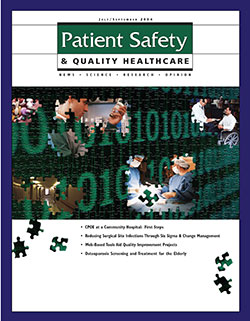 |
|
| July/August 2004 |
Lionheart Publishing launched the first issue of Patient Safety & Quality Healthcare (PSQH) in August 2004. Earlier that year, Pennsylvania implemented the first statewide mandatory reporting system (“Pennsylvania Is First State,” 2004); President George Bush pledged to make electronic health records available to most patients by 2014 (White House, n.d.), and Harvard sophomore Mark Zuckerberg launched Facebook (Facebook, 2014).
Anniversaries often inspire us to look back and take stock. In patient safety, the most recognized anniversary is the release in late 1999 (and publication in early 2000) of the Institute of Medicine’s report To Err Is Human, which called for a 50 percent reduction in medical errors in five years (IOM, 2000, p. 4). At the 10th anniversary, the patient safety community was largely underwhelmed by progress toward the IOM’s goals (Beresford, 2009; Wachter, 2009).
On July 17, 2014, patient safety expert Ashish Jha testified before the U. S. Senate Subcommittee on Primary Health and Aging and referenced the upcoming 15th anniversary of the IOM report, asking, “How much progress have we made?” (Jha, 2014, p. 1). His assessment is that, despite some gains, “…it seems we have not made much progress at all” (Jha, p. 3). The knowledge we have gained about safety and improvements made in some areas, especially infection control, are significant but not nearly enough.
Rather than add commentary about where we’ve been, we decided to use PSQH’s anniversary as a springboard to the future, at least the near future, and ask patient safety experts to project five years ahead. Where is the patient safety movement headed? What new issues will emerge? Among the current hot topics—hospital-associated infections, readmissions, unprofessional behavior, diagnostic errors, and others—which do think will be under control (or not) five years from now? How will changes in the delivery and business of healthcare affect improvement efforts? What about the rise of “engaged” patients?
Overall, people who responded to our questions expect modest improvement, mostly as continued progress in initiatives already underway, which is reasonable given that five years is a brief time relative to the glacial pace of change in healthcare. Some people identified new areas that expand our definition of patient safety, and a few don’t expect much change. Among that group, blogger and former hospital CEO Paul Levy predicted that healthcare will continue to be composed of “islands of excellence surrounded by a sea of mediocrity” because medical education is largely unchanged and hospital leaders are focused more on market concentration and the bottom line than on safety and quality.
Jim Conway, adjunct lecturer at the Harvard School of Public Health, also anticipates that variation in hospital performance will continue, often reflecting degrees of experience, i.e., where hospitals are on their quality and safety journey. Conway reminds us that there is no end to that journey and expects that “sustainability” will be a new challenge, especially for organizations that engage in isolated, limited improvement projects. Sustainability comes from system-wide commitment to continual improvement. Organizations that work to embody the principles of high reliability know that sustaining the gains they have made means never taking those gains for granted or believing that past or even performance offers protection from future hazards.
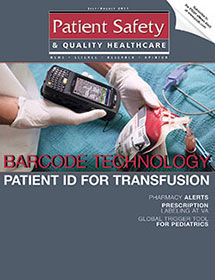 |
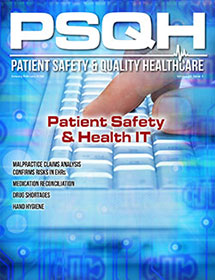 |
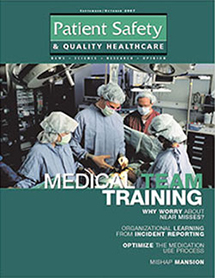 |
| July/August 2011 | March/April 2014 | September/October 2007 |
Tanya Lord, patient engagement coach and consultant at the Foundation for Healthy Communities in New Hampshire, is aware that for too many patients, in too many hospitals, the patient safety movement has not yet arrived or at least not been effective enough. Lord is an astute observer who comes to safety and quality improvement with a PhD in clinical and population health research and personal experience with harm from medical errors. Fifteen years ago, her 4-year-old son, Noah, died from a series of preventable errors following tonsillectomy (Lord, 2012). Lord travels the country telling Noah’s story and is struck to hear from audiences that similar stories can and still do happen in hospitals today, despite all that we’ve learned and many years of improvement work.
Author Charles Dickens’ overused statement about the “best and worst” of times seems to describe this moment in healthcare. The glass is half full or half empty depending on context and expectations. There are plenty of success stories, still too many tragedies, and an ever-larger world of healthcare in need of improvement. As we gain better understanding of what patients and their families experience, what consumers and professionals need and want, as well as what is possible when we overcome our fear of change, we see new potential for what can and must improve.
Workplace Safety |
|
Jerry Hickson, senior vice president for quality, safety, and risk prevention at Vanderbilt University Medical Center, thinks healthcare organizations will finally achieve the “right balance” in assessing the risks related to systems and individuals. According to Hickson, What we need for safety is good systems coupled with professional accountability. Achieving safety also requires the profession to get comfortable with a duty to self-regulate. I predict that over the next five years, health systems and medical professionals will develop the will and appropriate processes and tools to identify and intervene early with individuals who model behaviors that undermine a culture of safety. Responsible professional behavior must include following guidelines and refusing to make exceptions for unreasonable behavior. Bob Wachter, professor and chief of the division of hospital medicine at the University of California San Francisco, predicts, In areas where we can identify evidence-based patient safety practices, such as preventing healthcare-associated infections, there will be high levels of adherence, with more aggressive monitoring strategies, including those that use advanced sensors and video. The tolerance of organizations for substandard performance, including failure to clean hands or get flu shots, will go down considerably as the stakes grow. Tejal Ganhdi ties these efforts to our ability to attract and retain healthcare professionals in the numbers that we’ll need in the future and sees leadership as a necessary component: Ultimately, we need visionary leaders, skilled and caring line managers, and the means to continually give and receive feedback on safety issues, performance issues, and violations of respect to ensure that we have talented people entering the healing professions. |
Defining Patient Safety
As healthcare changes over the next five years, so will our concept of what patient safety entails. What constitutes a healthcare “setting” is beginning to encompass virtually any environment. As less intrusive treatment options; wearable sensors; and portable, secure communication pathways become more common, patients will receive care almost anywhere—in myriad medical settings, at home, while at work, or even in transit. How will our concept of patient safety keep up with these changes?
The patient safety movement in the 1990s and 2000s was focused almost exclusively on inpatient hospital services and has struggled to expand into physician offices and other ambulatory settings. What will it mean to be vigilant about patient safety when patients are even more mobile, more likely to be at home, not contained within a static healthcare setting or single institution?
And if we’re tempted to cut corners to accelerate our pace of change, National Patient Safety Foundation (NPSF) President Tejal Gandhi reminds us that new technology must be subjected to research and testing for safe use: “We are seeing a rise in telehealth and in the use of devices that allow for remote monitoring of patients. We need to have better identification of best practices for design and implementation of technology to optimize its benefits on patient safety.”
Maureen Bisognano, CEO of the Institute for Healthcare Improvement, describes the future of healthcare delivery and safety concerns in expansive terms:
We are beginning to look at safety across the entire continuum of care, moving beyond the walls of the hospital, clinic, or care facility to encompass the full scope of patients’ lives and care experiences.
Sunil Sinha, chief medical officer at Bon Secours Memorial Regional Medical Center and chair of the CME Committee for the American Board of Quality Assurance and Utilization Review Physicians, points out that increased focus on ambulatory settings should include attention to transitions of care “not only between hospital and home, but from home to primary care physician to specialist, to nursing home, skilled nursing facility, rehab, and so on. Establishment of accountable care organizations and clinically integrated networks will facilitate (or force) more collaboration and better use of community resources.”
Population Health
In addition to expanding the definition of care settings, we’ll expand patient safety’s traditional focus on procedural safety—wrong site surgeries, medication errors, hospital-associated infections, and more—to include population health and public health problems such as poverty, obesity, and health illiteracy. Dan Cohen, international medical director of Datix, remains cautiously optimistic that we will find solutions despite daunting problems he sees already at the door, related to deterioration in health of our population —in the United Sates and United Kingdom, both of which he calls home these days—especial related to obesity.
Safety issues related to managing population health include over- and under-use of health services, which are a challenging for institutions and healthcare professionals to manage and not well understood by the average consumer. Cohen says, “Every instance of unnecessary testing or intervention is a patient safety incident in my view, though the public does not generally see this.”
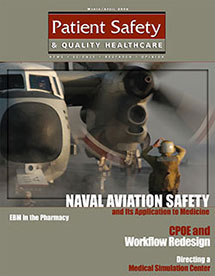 |
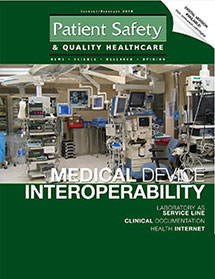 |
| March/April 2006 | January/February 2010 |
Patient Engagement and Transparency
Tracy Granzyk, director of patient safety and quality innovation at MedStar Health, answered my questions about patient engagement with some of her own:
With a call for greater patient engagement across the board, how far will this go? What level, or burden, of engagement will be required of patients in the future?
Mark Neuenschwander, consultant and co-director of The unSUMMIT for Healthcare Barcoding, agrees that patient compliance with medication regimens in particular is a “great frontier for quality and safety.” He hopes new wearable monitoring devices and further development of mobile technologies will help promote accurate, reliable, and safe self-administration of drugs.
Electronic Records and Analytics |
|
There is broad agreement that while electronic medical records (EMRs) will eventually make the healthcare system safer for patients, our current systems and approach to implementation are suboptimal and introduce new hazards. Chris Hartman, senior director of clinical quality and patient safety at Wolters Kluwer Health and founder of the Medication Safety Officers Society, recognizes that rapid deployment of electronic records has disrupted clinical workflows for physicians, nurses, and pharmacists. While I agree that interoperable data and the use of advanced clinical information systems is a necessary step in healthcare, I am concerned that unintended consequences of rapid implementations and workflow disruptions may actually be placing patients at risk. Bob Wachter, too, is concerned about the current state of EMRs but believes we’ll see better systems and more extensive interoperability by 2020. He warns of a new risk, however. Errors that penetrate those improved, mature systems, especially in organizations that are fully digital, will be difficult to address. Errors will still occur, and as our systems become more sophisticated, so must our ability to anticipate, track, and analyze problems. On the other hand, Wachter believes that applying analytics to electronic records will improve safety, for example, in the area of diagnostic error by “analyzing visit and admissions characteristics with the final diagnosis and showing areas of discordance.” Maureen Bisognano sees growing benefit in using data proactively for improvement, “taking a whole systems view of safety that will enable us to use data to predict potential risks and harm, then plan for, prevent, and manage them appropriately.” |
Reflections on the changing role of patients and families often lead to recognition of increasing pressure on health systems to provide information about the quality of care, patient safety incidents, and the cost of services. That pressure is being applied in various ways: public reporting of quality measures, global payment programs, and payers—including patients paying more out of pocket—shopping for value. Tejal Gandhi says, “As patients become more engaged in not only the quality but the costs of care, health systems are going to need to provide that information in a form that people find useful.”
Bob Wachter, professor and chief of the division of hospital medicine at the University of California San Francisco, sees the public taking more control (and the government less) of the process of rating physicians and hospitals and applying the kinds of tools most of us now use routinely to manage our finances, plan our travel, and purchase goods and services. Barry Chaiken, CMIO at Infor, agrees: “In the future, the patient safety movement will be driven more by consumerism than professionalism.”
Steve Powell, CEO and president of Synensis, agrees that patients will be increasingly motivated to shop around for cost and quality, often because they are bearing the costs more directly. Powell, who has extensive professional experience outside the United States, predicts that “a larger percentage of U.S. patients may choose medical tourism due to the huge cost savings available without compromising quality, where internationally accredited facilities may outperform for certain outcomes.”
Culture Change
Dana Siegal, director of patient safety services at CRICO Strategies, provides a striking example of culture change that offers hope for the future despite the fact that change is neither quick nor easy. Our questions about the future reached Siegal immediately after the annual CRICO/RMF patient safety symposium, which this year focused on culture change. Siegal had begun the symposium with a skit recalling entrenched habits of the past, especially smoking in hospitals.
As we looked back at the journeys that took us from shift reports in smoky back rooms to entire non-smoking campuses, we realized that there is hope in the adage, “It takes time.” It also takes vision, leadership, education, engagement, determination, persistence, and a willingness to step out of our current comfort zones if we are going to accelerate the changes that impact safety in measurable ways.
Hope for the Future
Responses to our questions about the upcoming five years display hope that new trends will get us closer to the “triple aim” of improved health for individuals and the population while improving the safe and efficient delivery of care. They also display frustration based on the complexity and difficulty of improvement work, with recognition that our healthcare systems remain flawed.
Among the most optimistic visions comes from Tracy Granzyk, based on her experience at the Telluride Patient Safety Summer Camp (Mayer, 2012). The camp offers intensive training and reflection for medical and nursing students as well as resident physicians. Tracy speaks for the program when she says,
Our hope is that [the campers’] youthful energy will propel the necessary cultural changes in medicine that will ultimately keep patients and providers safe, and return joy and meaning to the healthcare workplace. As Deming said, you don’t need everyone on board to create the needed change, just the square root of everyone.
Others note the ongoing need for inspirational, effective leaders in patient safety. Will fresh leadership and the square root of everyone be enough to make meaningful improvement in the next five years? Maybe not; in a recent conversation, a colleague pointed out that public policy needs to change, too, and can also be intractable:
Changes to pharmacy practice acts, for example, which are needed to permit pharmacists to industrialize and delegate their drug distribution activities, are likely to take 10- to 15-years or more. That may limit the ability of pharmacists (especially in the hospital community) to take their rightful place as providers of primary care to patients with chronic, medication-managed disease.
As safety and quality improvement work moves outside hospital walls, we will focus on improving safety in all settings and apply safety principles to population health. We’ll also continue to address changes in reimbursement and public policy. We may eventually approach a time when safety and quality no longer reside in isolated departments. Sunil Sinha agrees:
Due to the increased focus on pay for performance initiatives and transparency, I believe that the patient safety “movement” will pass from being just that, to become (if it is not already) firmly established as part and parcel of every aspect of care we provide.
Susan Carr is the founding editor and associate publisher of Patient Safety & Quality Healthcare. She may be contacted at susan.psqh@gmail.com.
APA Citation: Carr, S. (2014). Looking to the future of patient safety. Patient Safety & Quality Healthcare, 11(4), 30–35.
REFERENCES
Beresford, L. (2009, November). Medical mistakes, 10 years post-op. The Hospitalist. Retrieved from http://www.the-hospitalist.org/details/article/423625/Medical_Mistakes_10_Years_PostOp.html
Facebook. (2014, July 18). In Wikipedia, The Free Encyclopedia. Retrieved July 23, 2014, from http://en.wikipedia.org/w/index.php?title=Facebook&oldid=617466580
Institute of Medicine. Committee on Quality of Health Care in America. (2000). To err is human: Building a safer health system. L. T. Kohn; J. M. Corrigan, & M. S. Donaldson (Eds.). Washington, DC: National Academy Press.
Jha, A. (2014, July 17). Testimony before U.S. Senate Committee on Health, Education, Labor and Pensions. Subcommittee on Primary Health and Aging. Retrieved from http://www.help.senate.gov/imo/media/doc/Jha.pdf
Lord, T. (2012). Noah’s story: Please listen. Patient Safety & Quality Healthcare, 9(2), 38–41, 44. http://www.psqh.com/marchapril-2012/1197-noahs-story-please-listen.html
Mayer, D., McDonald, T., Doyle, S., & Wetzel, T. G. (2011). Telluride interdisciplinary patient safety roundtable: Medical students’ daily narrative reflections. Patient Safety & Quality Healthcare, 8(6), 42–46. http://www.psqh.com/novemberdecember-2011/1034-telluride-interdisciplinary-patient-safety-roundtable
Pennsylvania is first state to implement mandatory reporting system. (2004). Patient Safety & Quality Healthcare, 1(1), 34-35.
Wachter, R. (2010, January). Patient safety at ten: Unmistakable progress, troubling gaps. Health Affairs, 29(1), 165–173. Retrieved July 19, 2014, from http://content.healthaffairs.org/content/29/1/165.fulldoi.10.1377/hlthaff.2009.0785
The White House. (n.d.). Transforming health care: The president’s health information technology plan. Retrieved from http://georgewbush-whitehouse.archives.gov/infocus/technology/economic_policy200404/chap3.html
